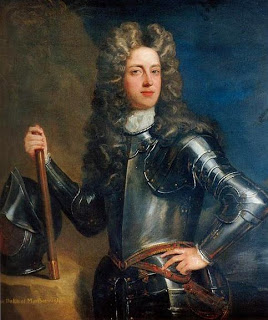Annotation:Audenard Battle: Difference between revisions
No edit summary |
No edit summary |
||
| Line 3: | Line 3: | ||
<p><font face="garamond, serif" size="4"> | <p><font face="garamond, serif" size="4"> | ||
'''AUDENARD BATTLE, OR LONDON SPYE'''. English, Jig. G Minor. Standard tuning (fiddle). AABB. The town of Audenaerd, or Oudenarde, is in Flanders (Belgium). | '''AUDENARD BATTLE, OR LONDON SPYE'''. English, Jig. G Minor. Standard tuning (fiddle). AABB. The town of Audenaerd, or Oudenarde, is in Flanders (Belgium). | ||
[[File:churchill2.jpg| | [[File:churchill2.jpg|300px|thumb|left|John Churchill, First Duke of Marlborough, 1650-1722.]] | ||
In 1708 an important engagement [http://en.wikipedia.org/wiki/Battle_of_Oudenarde] was fought between British and French forces in the War of the Spanish Succession, resulting in a resounding victory for the former, commanded by the Duke of Marlborough, John Churchill. Narcissus Luttrell writes in '''A Brief Historical Relation of State Affairs''' (1857) | In 1708 an important engagement [http://en.wikipedia.org/wiki/Battle_of_Oudenarde] was fought between British and French forces in the War of the Spanish Succession, resulting in a resounding victory for the former, commanded by the Duke of Marlborough, John Churchill (see also Playford's "[[Churchill's March]]). Narcissus Luttrell writes in '''A Brief Historical Relation of State Affairs''' (1857) | ||
<blockquote> | <blockquote> | ||
''A general thanksgiving is appointed to be on Thursday, the 19th of August,'' | ''A general thanksgiving is appointed to be on Thursday, the 19th of August,'' | ||
Revision as of 16:37, 11 November 2018
Back to Audenard Battle
AUDENARD BATTLE, OR LONDON SPYE. English, Jig. G Minor. Standard tuning (fiddle). AABB. The town of Audenaerd, or Oudenarde, is in Flanders (Belgium).

In 1708 an important engagement [1] was fought between British and French forces in the War of the Spanish Succession, resulting in a resounding victory for the former, commanded by the Duke of Marlborough, John Churchill (see also Playford's "Churchill's March). Narcissus Luttrell writes in A Brief Historical Relation of State Affairs (1857)
A general thanksgiving is appointed to be on Thursday, the 19th of August, for our late victory over the French, near Audenard, when her majestie, 'tis said, will goe to St. Pauls, and hear Dr. Fleetwood, bishop of St. Asaph, preach upon that occasion. An officer in our army in Flanders writes, that 'tis in their power to invest which of the enemies towns they please, but have not battering guns nor mortars nearer than Sas van Ghent, from whence 'twill be difficult to get them, so long as the French lye on the canal near Bruges; and that a strong detachment was sent to in large the ways for our marching to Rousselaer to straighten them. Tis said their army is diminish'd at least 20,000 men since the battle.
The melody was first published by I. Walsh and P. Randall in The New Country Dancing Master, 2nd Book (London, 1710). It subsequently appeared in several of the Walsh publications, including The Second Book of the Compleat Country Dancing Master (London, 1719), The Second Book of the Compleat Country Dancing Master, 3rd Edition (London, 1735), and The Second Book of the Compleat Country Dancing Master, 3rd Edition (London, 1749). It also appears in the later Playford editions, published by John Young: entitled The Second Volume of the Dancing Master, or Directions for Dancing Country Dances (London, editions of 1710, 1714, 1718, and 1728). The second part only consists of six measures.
Source for notated version:
Printed sources: Barnes (English Country Dance Tunes, vol. 2), 2005; p. 6.
Recorded sources:
